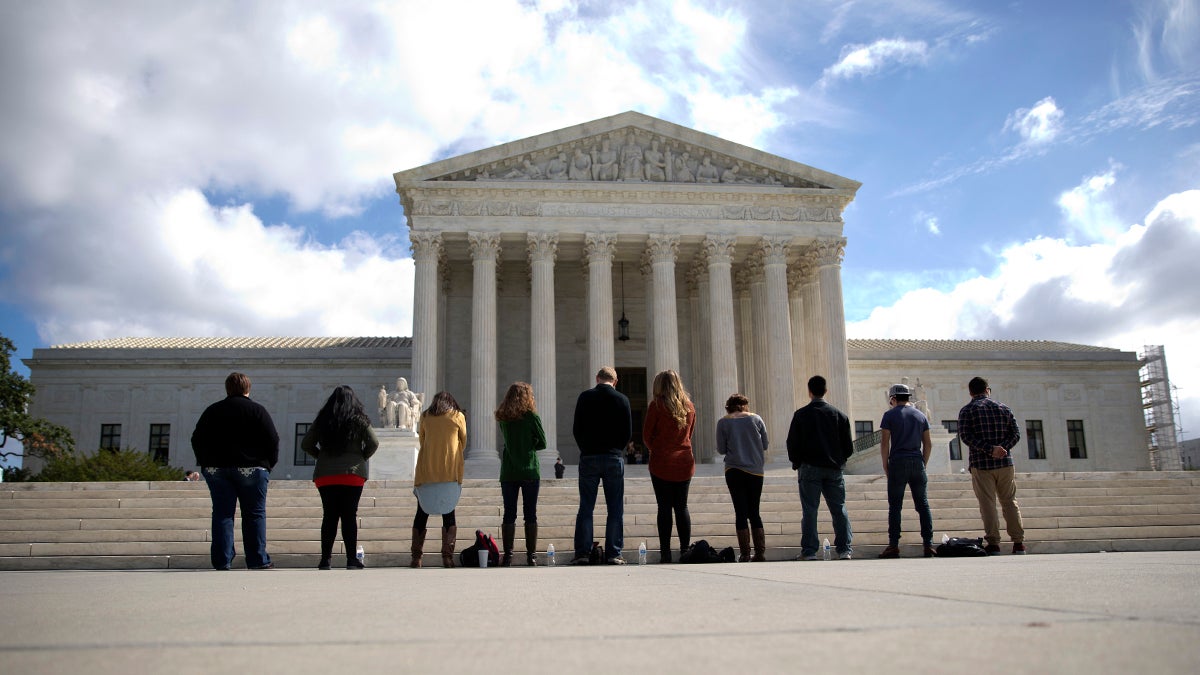Explainer: A court decision means that in housing discrimination cases, outcomes matter as much as intent

Protesters gather in front of the Supreme Court in Washington, D.C. (AP Photo/Carolyn Kaster)
The decision affirms a community’s right to sue a city or a housing authority if it sees a policy creating unfair housing patterns.
Fair housing advocates were feeling jittery last spring, as the U.S. Supreme Court was gearing up to rule on a case involving the supposedly uneven allocation of low-income housing tax credits in Texas.
An advocacy group called the Inclusive Communities Project had sued the Texas Department of Housing and Community Affairs, alleging that the Department had disproportionately distributed the tax credits, which are used to develop affordable housing, in black neighborhoods as opposed to white neighborhoods. The claim wasn’t even really an allegation, because it was based on data: more tax credits had in fact been distributed in black neighborhoods. It was a claim of “disparate impact,” rather than “disparate treatment.”
The difference is important. A claim of disparate treatment is the kind of thing most people associate with discrimination: refusing to rent to someone because of the color of their skin or some other plainly racist behavior. A disparate-impact claim looks at outcomes. Some policies disproportionately harm one group and benefit another, even if they weren’t created to do so.
In its defense, the Department claimed that the Fair Housing Act of 1968 only outlawed disparate treatment. Courts had been accepting disparate-impacts claims for decades, but now the Department was challenging that aspect of the law at the highest level. The Supreme Court had recently struck down other parts of landmark civil rights legislation of the 1960s, and advocates feared it would do the same with aspects of the Fair Housing Act. The fallout from that could be detrimental to their cause. It’s much more difficult to prove a housing administrator is racist than it is to prove that a housing policy has racially imbalanced outcomes.
So advocates were relieved when the Court ruled, 5-4 — in favor of the advocacy group — that claims of disparate impact were legitimate in the eyes of the law. In a close read of the original Fair Housing Act and subsequent amendments passed by Congress, the Court said that the “the operative text looks to results.”
“Recognition of disparate-impact liability under the FHA plays an important role in uncovering discriminatory intent: it permits plaintiffs to counteract unconscious prejudices and disguised animus that escape easy classification as a disparate treatment,” the Court wrote.
In upholding the importance of disparate-impacts claims, the Court also limited them. In order to pursue such a claim, a complainant would have to show that the imbalance is directly caused by some aspect of the policy in question. Simple statistical disparities aren’t enough to bolster a claim of disparate impacts, the court said. If they were, housing authorities could resort to racial quotas, which may not be constitutional. Claims of disparate impact must show that the disparity is caused by the policy.
The decision pleased advocates. But it also created a small conservative backlash, as Jamelle Bouie described in an L.A. Times piece. Some conservative writers viewed the decision as an attack on the sanctity of the suburbs. No amount of de-segregation law will ever produce a perfectly balanced mix of racial groups in every community, and that shouldn’t be the goal, wrote Michael Barone in the Washington Examiner.
“Free choice inevitably has a disparate impact,” Barone wrote.
In the end, the Supreme Court’s decision simply affirms a community’s right to sue a city or a housing authority if it sees a policy creating unfair housing patterns.
“De jure residential segregation by race was declared unconstitutional almost a century ago …” the Court concluded, “but its vestiges remain today, intertwined with the country’s economic and social life.”
WHYY is your source for fact-based, in-depth journalism and information. As a nonprofit organization, we rely on financial support from readers like you. Please give today.


